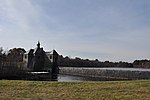WSRO

WSRO (650 AM HD Radio) is a radio station that is silent. Licensed to Ashland, Massachusetts, it serves the MetroWest area. The station is owned by Alex Langer. WSRO also operates translator station W271CU (102.1 FM) in Framingham. Rooted in a station in Peterborough, New Hampshire, WSCV (later WMDK and WRPT), that operated from 1970 to 1991, the WRPT license was moved to Ashland in 1997. Initially relaunching as a talk station, the station later moved to religious programming, before spending much of the 2000s and 2010s as a Portuguese station for Framingham's Brazilian community. After the station ended its Brazilian programming and went silent in 2020 due to financial problems, it became a jazz station. It converted from analog to digital-only operations in 2021, and moved to a classical music format in 2022, before again going silent in 2023 following Langer's death.
Excerpt from the Wikipedia article WSRO (License: CC BY-SA 3.0, Authors, Images).WSRO
Mount Wayte Avenue, Framingham
Geographical coordinates (GPS) Address Nearby Places Show on map
Geographical coordinates (GPS)
| Latitude | Longitude |
|---|---|
| N 42.288055555556 ° | E -71.431388888889 ° |
Address
WKOX-AM (Framingham)
Mount Wayte Avenue
01702 Framingham
Massachusetts, United States
Open on Google Maps








